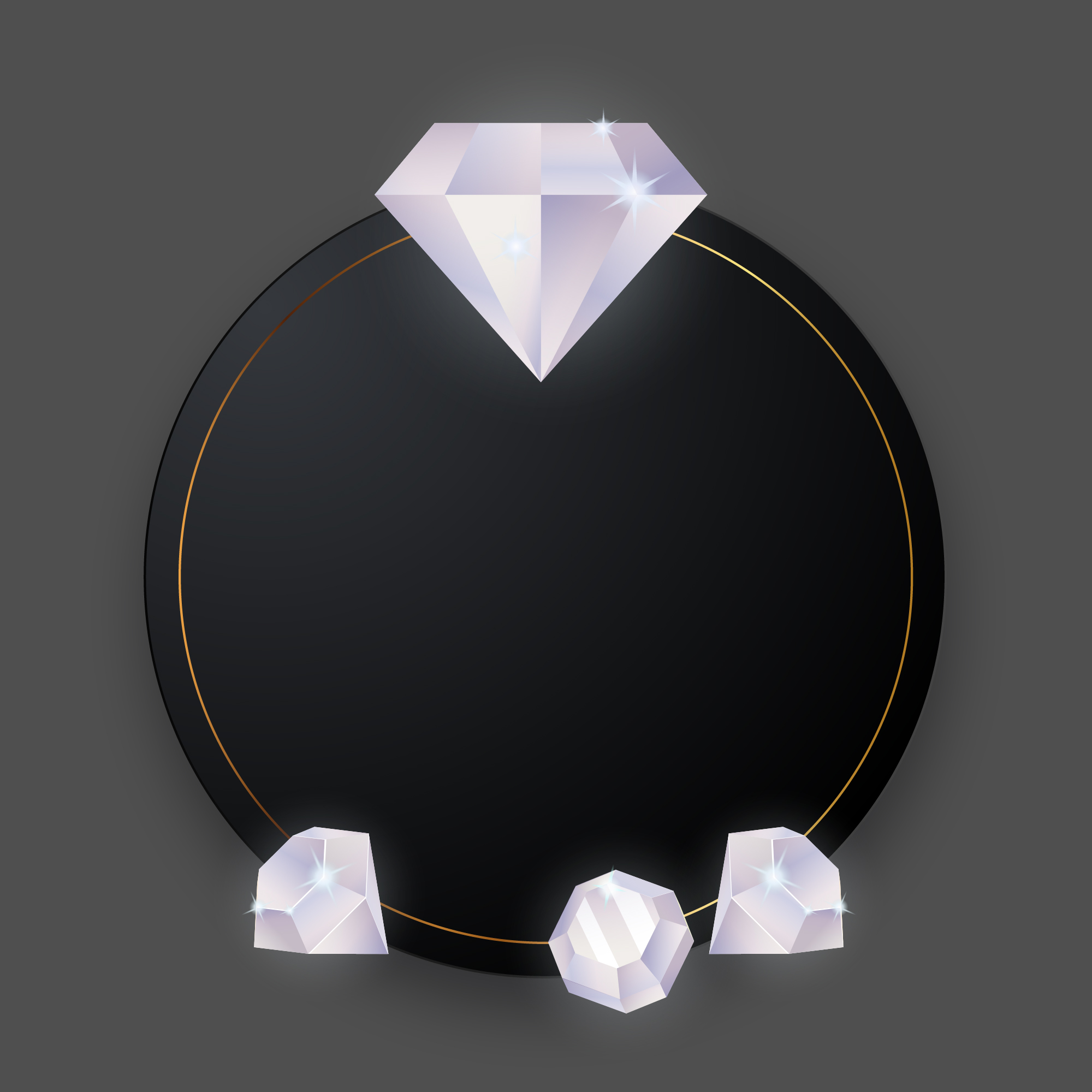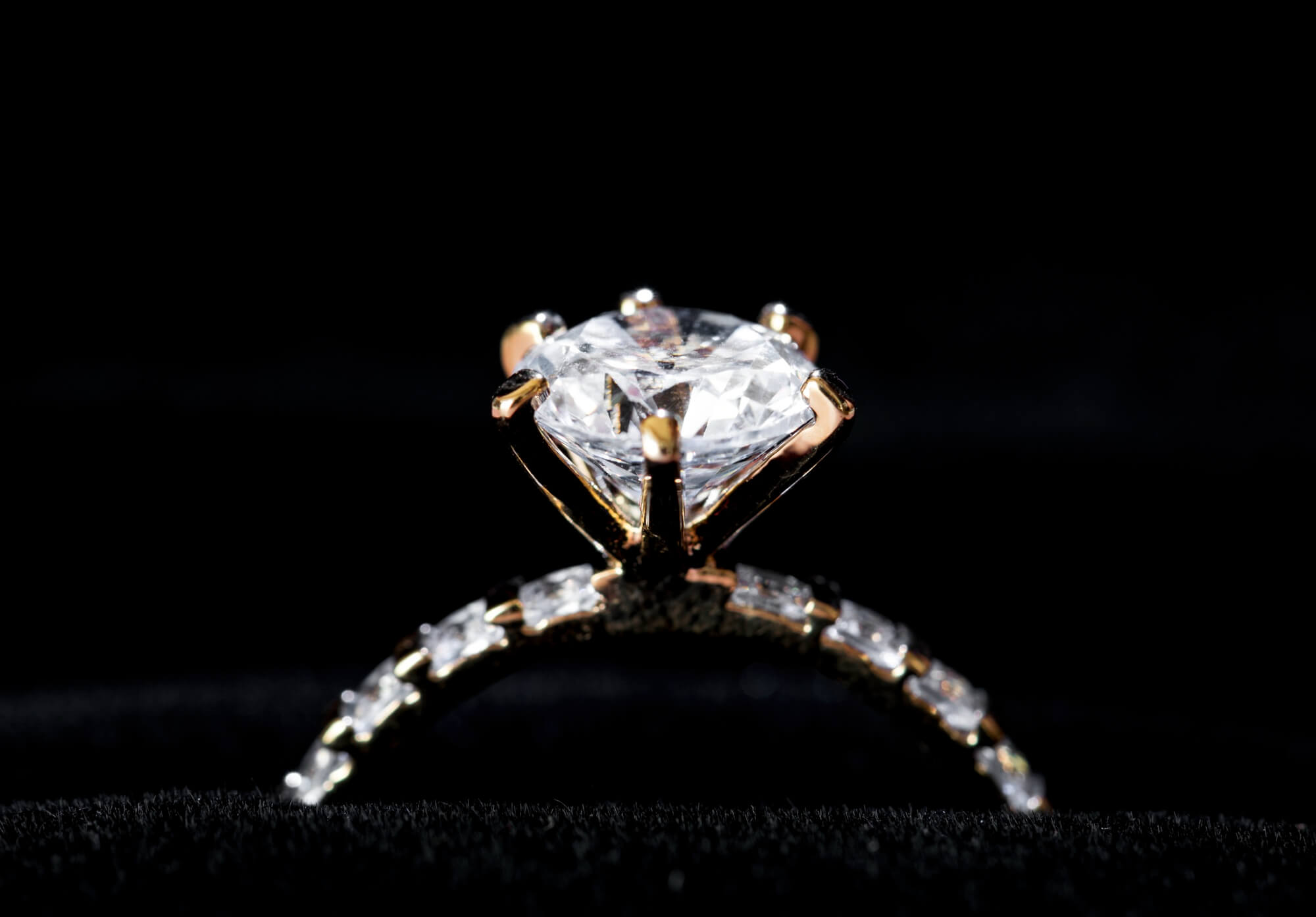CHAMELEON DIAMOND
Welcome to the fascinating world of chameleon diamonds, where the enigmatic beauty of interchangeable colors and uniquely rare pieces of treasure meet. Known for their ability to change their color when exposed in light or dark places, chameleon diamonds captivate the eyes of enthusiasts and collectors due to their rare ability and uniqueness, marveling at the world with their innate ability. This extraordinary characteristic and ability have fascinated and intrigued the world for many decades as soon as they were discovered.
In this article, we will discuss everything related to chameleon diamonds, from their rise in popularity to jewelry applications and celebrities and famous personalities who wish to use them as a fashion statement or for their casual attire. Furthermore, we will discuss their cultural significance, traditionally and in modern applications. We will dive deeper into their potential in the investment realm and learn more about their pricing and quality grading. We will also discuss several essential pieces of knowledge that need to be learned before making any informed decisions about purchasing them.
Now, let us begin this extraordinary journey by asking the most critical question: what is a chameleon diamond?
What is a Chameleon Diamond?
Chameleon diamonds belong to a group called colored diamonds. They are a rare type of diamond known for their ability to change color when subjected to light or dark spaces. Chameleon diamonds are the only diamonds that can do this trick, and this ability sets them apart from other colored diamonds.
They have also been formed deep beneath the Earth’s mantle for billions of years and in extreme environmental conditions such as extreme heat and pressure. Its composition and structure are still a mystery for scientists and gemologists; however, it is hypothesized that it may have involved hydrogen and nitrogen elements in its formation, causing it to have a grayish-yellow green in normal conditions.

Explore all types of chameleon diamonds
Chameleon diamonds, known for their mesmerizing and one-of-a-kind beauty, have different color types that separate them uniquely into categories based on their stable and temporary colors. There are four color types of a chameleon diamond: classic chameleon, reverse chameleon, intense yellow chameleon, and rare blue-green chameleon diamond. Every kind of chameleon diamond offers a beautiful palette of colors that changes in certain conditions. Here are some brief explanations for this:

Classic Chameleon Diamonds
The primary color of classic chameleon diamonds has lighter tones that range from green up to yellow-green without being exposed to any lighting conditions. When subjected to heat or lighting conditions, they change their colors to a warmer or a darker hue that ranges from yellow, orange, or even brownish colors.

Reverse Chameleon Diamonds
This type of chameleon diamond is a reverse from a classic chameleon diamond. Their standard color typically shows a darker tone compared to the classic chameleon diamond; it ranges from a deeper green up to a grayish color. The change of their color is a direct reverse from classic chameleon; their color often lightens when subjected to heat or kept in darkness, and they restore their color once average temperature and light are restored.

Intense Yellow Chameleon Diamonds
As the name suggests, intense yellow chameleon diamonds offer a vividly yellow standard color when in average temperature and lighting conditions. They transition into a deeper orange or even up to a reddish tone when subjected to heat or light, and they return to their standard color when the temperature and lighting are restored. This type of chameleon diamond typically displays a more vibrant yellow compared to classic chameleon diamonds.

Rare Blue-Green Chameleon Diamonds
This is the rarest type of chameleon diamond; they offer an exquisitely unique bluish-green color, which makes them more valuable and collectible in contrast with all the chameleon diamonds. Their regular bluish-green color changes into teal or even up to blue when subjected to heat or light conditions; they revert back to their usual color when their environment is back to normal. Due to their scarce characteristics, they are often sought-after by collectors and enthusiasts, and they are only sold in the most exclusive auction houses and jewelry stores.
Cultural Significance: Chameleon Diamonds in Traditional and Modern Jewelry
The mysterious allure of chameleon diamonds in our culture not only fascinates scientists and gemologists but also transcends traditional applications and modern fashion designs. Their artistic symbolism is expressed by artisans and jewelers in their most creative ways. In tradition, they are often used as a symbol of love and purity, while in contemporary jewelry designs, they mainly symbolize adaptability and change, making them applicable for any jewelry setting and casual or formal attire.
Like any colored or colorless diamond, its cultural significance is often associated with luxury, wealth, and beauty. High-value persons and celebrities often use them as jewels that complement their evening dresses, casual or everyday attire, or even for financial reasons such as investments and portfolio diversification. The possibilities of chameleon diamonds go beyond their historical importance to their contemporary use in fashion, investment, and glamorous statements.
Quality and grading of chameleon diamonds
The quality and grading of chameleon and colored diamonds have similarities, including their basic gradings like checking the clarity, cut, and carat weight; but in terms of color, chameleon diamonds differ from the grading and quality checking of colored diamonds due to their color-changing properties, which are unique in their own way and set them apart from any other gemstones, particularly their group, the colored diamonds. Here are some notable differences on their quality and grading.
4Cs, Particularly Their Color – In colored diamonds, the 4Cs of a diamond, namely cut, clarity, carat weight, and color, are primarily checked for quality by the use of special machines and equipment. To determine the quality of a chameleon diamond, scientists and gemologists conduct tests that evaluate its overall beauty. Here is a brief explanation of how they check the 4Cs of a chameleon diamond.

Color
The most significant factor of a chameleon diamond is its color; it is graded for uniformity and stability, their color changing ability in dark or light settings, their saturation of hue or the strength of their color, and the rareness of the color they exhibit.

Clarity
Like any diamond, colorless or colored, clarity refers to the number of blemishes and inclusions that can be found on a diamond. The fewer the inclusions and blemishes on the chameleon diamond, the higher its price or value in the market.

Cut
The cut refers to a diamond's overall facets. In chameleon diamonds, a cut is checked for its ability to exhibit its natural change of color. An ideally cut chameleon diamond enhances the stone's brilliance, maximizes the impact of the changing of colors, and signifies its value and desirability in the market.

Carat Weight
Carat weight, as per any diamonds available, refers to the overall weight of a diamond after being cut. A larger chameleon diamond is considered rare and can be highly desirable when it has a good cut, color, and clarity.
Chameleon Diamond Cuts and Shapes
Colorless diamonds are cut and shaped into different types to enhance their brilliance, reveal their inner beauty, and effectively reflect light. Colored diamonds, particularly chameleon diamonds, are cut and shaped to enhance the gem’s unique innate ability to change colors. Choosing the proper cut and shape dramatically affects the diamond’s overall value, enhancing its beauty, brilliance, and even the chameleon effect. Here’s a little overview of the most popular cuts and shapes for the chameleon diamond.
Round Brilliant Cut
This is the most popular cut available for all diamonds due to its shape and ability to reflect light. The round brilliant cut enhances the chameleon diamond’s brilliance, making it appear fierier when subjected to lighting settings. Due to its shape, the round brilliant cut can also affect subtle changes of color, allowing the chameleon diamond to achieve its maximum potential when it comes to their ability to change colors.
Cushion Cut
The cushion cut is famous for its rounded corners and larger facets, which allow a diamond to appear larger when set in jewelry. It also emphasizes the color of a diamond throughout the jewelry. Due to its large facets, a cushion cut would be the best shape for the chameleon diamond to express its uniqueness when it comes to its color-changing properties.
Oval Shape
The oval cut or shape is a round brilliant cut with an elongated top facet. It offers a bit of enlargement but not in weight, and its unique symmetry allows the diamond to showcase its natural color. This cut is perfect for centerpiece diamonds due to its proportions, which allow the diamond to appear larger in a jewelry setting.
Pear Shape
When it comes to femininity and elegant design, the pear shape-cut diamond is one of the go-to shapes due to its unique blend of soft curves and an intricate design that captures light beautifully. The pear shape is a combination of round and marquise cuts with a single pointy end and a rounded end on the other side. It is also called a teardrop shape, and it is perfect for the chameleon diamond due to its shape, which makes the color change ability more dramatic and can be visible from all angles.
Comparing Chameleon Diamonds to Colorless Diamonds
Both chameleon and colorless diamonds have their own strengths and weaknesses when compared side by side; they also have their specific usages in jewelry settings, and they can both make jewelry exhibit its most beautiful potential, making its value appreciate more. While sharing their essential gemological characteristics as a diamond, both of these diamonds have their distinct appeal and rarity, offering a wide variety of jewelry and complementary accessories for fashion and luxury.
Colorless diamonds are known for being timeless pieces of jewelry and are prized for their lack of color and purity. They are often sought after when they show no or minimal inclusions or blemishes, which is similar to an icy appearance. Large colorless diamonds with minimal or no inclusions are often rare. However, although usual colorless diamonds are more common than chameleon diamonds, they are still valued highly, especially those with higher quality and grades.
On the other hand, chameleon diamonds are known for their ability to change color when subjected to heated or lighting settings. Due to this unique ability, they are significantly rarer than colorless diamonds. They are highly valued and are often sought-after by collectors and investors for their unusual appearance and beauty.

Crafting Distinctive Jewelry Designs with chameleon diamonds
When it comes to distinctive jewelry, uniqueness and rarity play a big part. This is why chameleon diamonds are perfect for this one-of-a-kind jewelry that anyone would be interested in having. Due to their distinct ability to change colors in specific heat or light settings, chameleon diamonds are often used as a centerpiece for any unique jewelry design that a customer desires for their custom piece. Here, we compiled some of the best uses of chameleon diamonds in distinctive jewelry designs.

Engagement and Wedding Rings
Chameleon diamonds set in a centerpiece for a wedding or engagement ring can offer the jewelry a distinctive feel due to their rare ability to change color when subjected to heated or lighted settings. This ability can add romance and an act of surprise for engagement purposes, while for wedding purposes, it can act as a symbol of the ever-evolving nature of love.

Pendants and Necklaces
The color-changing ability of chameleon diamonds when set in necklace jewelry can be maximized to its best potential looks by using platinum, rose or white gold, or any metal with plain color. Then, surround the centerpiece chameleon diamond with small colorless diamonds to enhance its effects and make the jewelry distinctive and beautiful.

Earrings
The unique beauty and mesmerizing appeal of the chameleon diamonds, when incorporated in a piece of earring jewelry, create a new look and add sophistication to its beholder. Chameleon diamonds can be incorporated, whether from stud, dangle, cluster, or teardrop type of earrings. To create a stunning piece of earring jewelry, the chameleon diamond must have stones that are plain in color to accentuate its beauty and be able to see its color change dominantly.

Bracelets
Whether for charm, tennis, bangle, or any type of bracelet that has a centerpiece stone, the beauty of the chameleon diamond knows no limit when it comes to unique and intriguing design. Directly position the chameleon diamond as a centerpiece in bangles surrounded with same-sized shiny colorless diamonds to enhance the sparkle of the jewelry; place it in a rose gold setting, and that would make a stunning piece of art.

Custom Jewelry Design
To create a custom jewelry design, finding a professional jeweler or jewelry designer is what matters most. A seasoned jewelry designer can turn any chameleon diamond into custom-made jewelry or accessories into a beautiful and dazzling piece. Just remember to always look for jewelry artists who are well-known in this field, have a good reputation, and have a history of high-value clients who approve their work.
What to Look For in a Chameleon Diamond Jewelry?
When planning to purchase chameleon diamond jewelry, several factors need to be addressed to ensure the quality and authenticity of these precious stones. Due to their unique ability, chameleon diamonds have different considerations, which can significantly determine their value and worth in the market. Here are some of the notable factors to check or look for when purchasing chameleon diamond jewelry.

The ability to color change
Check for the chameleon diamond’s ability to change its color, it can impact its overall value, and they should exhibit a clear and distinct change. Also, check for its base color; it can range from colors green, yellow, brown, or even red, it should complement the whole jewelry.

The quality of its 4cs
Always check for the 4cs of a diamond (Cut, Clarity, Color, and Carat Weight). Colorless and colored diamonds always use this grading system to determine the overall value and worth of a diamond in the market.

Diamond setting and style
The metal setting of a chameleon diamond needs to complement its interchanging colors, whether from primary up to totally changed; the metal settings of jewelry need to make the diamond excel in jewelry. Always go for metal settings that have a plain color, like rose or white gold and platinum settings.

Certification
To ensure the authenticity of a chameleon diamond jewelry, it must come with a certificate from any of the most reputable institutes which provide detailed and unbiased examinations and assessments in a diamond.

Investment or resale value
The unique feature of a chameleon diamond may attract investors, collectors, and enthusiasts who wish to pay a fortune in exchange for this rare diamond. Always do research about their investment potential and resale value to get the most out of these beautiful and unique gems.
Investment Insights: Why Chameleon Diamonds Are Gaining Value in the Market
The allure of the chameleon diamonds and their color-changing properties are catching the attention of seasoned investors, collectors, and enthusiasts when it comes to investment; their breathtaking ability allows them to gain a surge in their demand and desirability. There are several factors as to why the demand for chameleon diamonds is continuously gaining popularity and value in the market. These crucial factors directly affect their value and worth, which is why these diamonds keep on growing in value and are predicted to never slow down in many years to come.
Here are some of the most critical factors as to why chameleon diamonds are gaining value in the market and the investment industry.
Unique Ability and Increasing Rarity
When it comes to uniqueness in terms of ability, the chameleon diamond is the rarest piece of diamond the Earth has ever produced. Their ability to change color is what sets them apart from any other diamonds in the market. Their increasing rarity due to some closure of mines makes them highly valuable for investors and collectors, making their value continuously grow in many years to come.
Growing Demand
The demand for these chameleon diamonds, particularly in contemporary use, is constantly growing due to some famous appearances and high-value personalities who choose to wear them at red-carpet events. Their growing demand also significantly impacts their value in the investment and collectible industry, making them a viable option for investment and asset purchase.
Collectability
Chameleon diamonds are the only diamonds that can change their primary color to different shades and intensities in different environmental settings. With that being said, they are the most collectible gemstones out in the market, making them highly valuable for specific people who wish to collect these exciting and one-of-a-kind diamonds, making their value skyrocket year after year.
Investment Potential
Investing in the chameleon diamonds is a good idea based on investors, collectors, and enthusiasts. Its potential to dominate the investment realm is highly likeable due to their current status as an emerging tangible asset of the future. Their rarity and unique ability can potentially lead to a significant rise in their value, especially now where more people desire uniqueness in diamonds.
Diversification of Portfolio
Nowadays, investors and collectors often find ways to diversify their assets in many different types of investments. They do this solely to mitigate risks and potentially avoid loss on their investments. Seasoned investors are eyeing to put some of their hard-earned money into these chameleon diamonds because they can see their potential and what their future holds; plus, they are using these diamonds to diversify their portfolio and avoid any significant loss in the future.
Chameleon diamonds are some of the most thrilling investments in the market today. While they offer a mesmerizing display of colors and their ability to change when subjected to the right environment, their rarity is what drives their value in the market. Making the best decision when investing in any particular asset requires proper knowledge, informed research, and the right guidance to ensure that any future purchase is going to be the best purchase an individual has ever made.
Celebrity Style Spotlight: Chameleon Diamonds Making Waves on the Red Carpet
Chameleon diamonds are making their way through celebrities’ jewelry and outfits with their unique ability to change colors when set in different lighting conditions. High-profile events such as galas, awards nights, and red-carpet events are some of the most star-studded events in which celebrities gather and display their unique jewelry accessories, which dazzle people from all around the world. Here are some of the celebrities who embraced the chameleon diamonds in their outfit and fashion statements.

Rhianna
Known for her famous songs like Umbrella, Disturbia, and Diamonds, Rhianna has embraced the enigmatic beauty and rarity of chameleon diamonds, incorporating them into her jewelry collections and dynamic fashion sense. She was seen wearing a chameleon diamond necklace at the Met Gala in 2021, expressing how the diamond mirrored the evening’s theme of change and metamorphosis.

Angelina Jolie
The famous actress and filmmaker wore chameleon diamonds as earrings at the Academy Awards. She described it as captivating and deeply personal, mirroring her uniqueness and complex personality.

Johnny Depp
As seen by the paparazzi and media at many famous events, Johnny Depp was seen wearing a custom-made cufflink chameleon diamond set at the Film Festival. He showcased the diamond’s uniqueness, rarity, and ability to change color when subjected to different light settings.
Chameleon diamond certification
The certificate for a chameleon diamond is the same as other certificates; it needs to be from reputable gemologists like the Gemological Institute of America (GIA), International Gemological Institute (IGI), or American Gem Society (AGS). These reputable institutes and laboratories offer an unbiased assessment of any kind of gemstone, including these rare chameleon diamonds. They have the state-of-the-art equipment needed for checking them and several professional scientists and gemologists who provide professional assessments.
In this business, we provide proper certificates and documentation for any jewelry we sell. We assure you that they are all legitimate, authenticated, and quality-checked by the most reputable institutes and laboratories like the GIA. We ensure that all of our current and future clients will gain our trust and create a lasting relationship that is built on trust. Our primary goal in this business is to remove the doubt of our clients and to have their contentment fulfilled.

Verifying Authenticity: A Guide to Checking Chameleon Diamond Validity
Several essential factors need to be checked to verify the authenticity of a chameleon diamond. Verifying its validity and authenticity is the first thing to do when planning to purchase a chameleon diamond for fashion, jewelry statement designing, or even for investment purposes. These rare gemstones are often counterfeited, which is why learning about their origins and authenticating them is a crucial factor that every potential buyer needs to address before buying any kind of chameleon diamonds in the market.
We created a step-by-step guide on how to verify the authenticity of a chameleon diamond and how to differentiate counterfeit from original and synthetic.
Get a Certificate
Every diamond needs to have its certificate, especially these rare chameleon diamonds, because they are often counterfeited and resold at a much higher price than their resell value. Get a certificate from the most reputable institutes like the Gemological Institute of America, which offers unbiased assessments and innovative technology.
Color Change
Find a professional who can test out the color change of a chameleon diamond to avoid any unnecessary damage it could create. Test the diamond by placing it into heated or lighted surroundings to check how quickly or how deeply the color change occurs.
Inspect for Inclusions and Blemishes
An individual may need a loupe or microscope to do this. Find any natural inclusion or blemish that occurs genuinely on a natural chameleon diamond. A blemish-free or no-inclusion chameleon diamond might be a sign that it is synthetic or treated.
Evaluate with a Professional
Always evaluate with a professional or find a trustworthy gemologist or scientist before purchasing any kind of diamond, especially rare ones like these chameleon diamonds. A professional gemologist can provide a detailed breakdown of the diamond’s properties, confirm a certificate’s authenticity, and provide any additional assessment to ensure the diamond’s quality.
Lab Grown vs. Mined Chameleon Diamonds
Synthetic or lab-grown chameleon diamonds have several significant differences between naturally mined chameleon diamonds. These differences contribute to their overall value and desirability in the market. While both gemstones have the same structural components, they mainly differ in some crucial aspects that investors, collectors, and enthusiasts find when purchasing chameleon diamonds. Here are their detailed differences from each other.
| Factor | Synthetic or Lab-Grown Chameleon Diamonds | Naturally Mined Chameleon Diamonds |
|---|---|---|
| Origin | Created in a controlled laboratory environment. | Extracted from Earth from diamond mines. |
| Color-changing Ability | Engineered to copy the ability of the natural chameleon diamond. | Naturally occurring color change due to structural properties. |
| Cost and Value in the Market | Less expensive due to controlled production costs. | More expensive due to the extensive mining and processing involved. |
| Availability or Supply | More readily available and can be mass produced. | Much rarer in supply and their availability depends on the natural occurrence and mining yields. |
| Investment Potential | Has a low investment potential due to their higher supply and lower demand. | Has a greater investment potential due to their higher demand and lower supply. |
Factor
Origin
Color-changing Ability
Cost and Value in the Market
Availability or Supply
Investment Potential
Synthetic or Lab-Grown Chameleon Diamonds
Created in a controlled laboratory environment.
Engineered to copy the ability of the natural chameleon diamond.
Less expensive due to controlled production costs.
More readily available and can be mass produced.
Has a low investment potential due to their higher supply and lower demand.
Naturally Mined Chameleon Diamonds
Extracted from Earth from diamond mines.
Naturally occurring color change due to structural properties.
More expensive due to the extensive mining and processing involved.
Much rarer in supply and their availability depends on the natural occurrence and mining yields.
Much rarer in supply and their availability depends on the natural occurrence and mining yields.
Quick Facts about chameleon diamonds
- Chameleon diamonds are the only known diamonds that can temporarily change their color when exposed to different environmental settings.
- There are two main types of chameleon diamonds: classic chameleon diamonds and reverse chameleon diamonds.
- Chameleon diamonds are exclusively rare diamonds.
- Due to their rare occurrence and ability to change colors, chameleon diamonds are some of the most sought-after diamonds by collectors and investors.
- The chameleon diamonds symbolize adaptability and change.
- The first study about these natural chameleon diamonds occurred in the 1940’s.
- They are graded the same as any diamonds by the use of 4cs. However, their color-changing capabilities are additionally documented in their gemological certificates.
FAQs
How much are chameleon diamonds worth?
The worth of a chameleon diamond depends on its 4cs and its color-changing ability, which professionals and institutes assess.
What are chameleon diamonds called?
Chameleon diamonds are called by their name because they can change their color like the animal chameleon.
How rare are chameleon diamonds?
They are extremely rare and considered to be one of the rarest diamonds in history.
Where do chameleon diamonds come from?
They came from Zimbabwe, Angola, and the Democratic Republic of Congo.
How are chameleon diamonds formed?
They formed the same as any natural diamond, but they only differed in the presence of certain trace elements and structural defects.
What do chameleon diamonds symbolize?
They symbolize change and adaptability.
Final Verdict
In conclusion, chameleon diamonds are continuously fascinating the world of natural-colored diamonds and fashion jewelry in an elegant way. Due to their ability to temporarily change colors in a unique way, investors and collectors are still yearning to have a piece of this extraordinary treasure that our Earth has produced.
As we end this journey, we hope that you have learned fascinating facts about the world of chameleon diamonds and all of their wonders. We thank you for joining us in this extraordinary experience, and we will keep doing this so that you can better understand the world of sensational colored diamonds.




